Reindeer and deer are remarkably different in several ways.
Reindeer, living in the Arctic regions, are semi-domesticated and used by humans for transport, food, and clothing. Unlike many deer, both male and female reindeer develop antlers. Deer, contrarily, are typically wild creatures occupying various habitats worldwide. Generally, only male deer grow antlers. They are often considered a concern in urban areas due to their plant-eating habits.
Though reindeer and deer share the same family, these creatures lead lives that are poles apart.
Ever wondered why reindeer can withstand the frigid cold of the Arctic while deer are found in diverse climates? Curious to uncover the unique distinctions between these two species?
Join us as we explore their fascinating world, untangling the mysteries that make them unique. The adventure begins here. Let’s journey together!
Reindeer vs Deer – A Quick Comparison
| Feature | Reindeer | Deer |
| Scientific Name | Rangifer tarandus | 43 different species |
| Body Shape | Sturdy body with shorter legs | Generally slender body with longer legs |
| Size | Weigh nearly 150 – 550 pounds; about 5.5-6.5 feet long; 2.5 – 5 feet tall | Varies by species, 20 pounds to over 1,000 pounds; |
| Diet | Mostly lichens in winter; a variety of vegetation in other seasons | Herbivorous, feeding on a mix of grasses, leaves, shoots, berries, and herbs |
| Habitat | Arctic and sub-Arctic regions | Diverse habitats worldwide |
| Social Behavior | Generally gregarious; herded by humans in some cultures | Both solitary and social behaviors depending on the species |
| Lifespan | 10-15 years in the wild | 3-10 years on average in the wild |
| Gestation Period | Approximately 7 months | About 6.5-7.5 months |
| Defense Mechanisms | Speed, swimming, herd protection, antlers | Speed, agility, camouflage, some males have antlers |
| Interaction With Humans | Semi-domesticated, used for transportation, meat, and clothing | Mostly wild, hunted for meat and sport, can be a nuisance in suburban areas |
| Threats | Climate change, habitat fragmentation due to human activities | Habitat loss, hunting, road accidents |
| IUCN Status | Vulnerable | Range from Least Concern to Endangered |
Reindeer vs Deer – What Are The Key Differences?
Reindeer and deer are bound by their shared ancestry under the umbrella of the same family. Both have evolved unique adaptations to survive in varied environments. Their diet mainly comprises vegetation, and they have developed distinct seasonal behaviors linked to mating and survival.
However, reindeer and deer exhibit many differences that are as diverse as their habitats. So, let’s delve into their world and unearth their fascinating differences.
Taxonomy and Scientific Classification
Deer is a broad term encompassing many species of hoofed mammals in the family Cervidae, and reindeer are one species within that family.
Reindeer
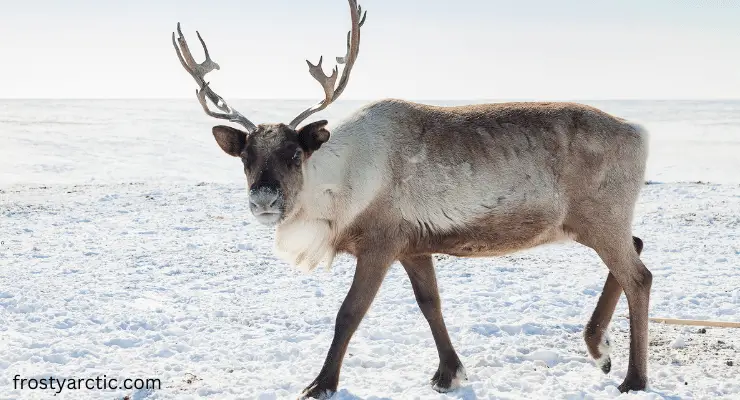
Scientifically, reindeer are called Rangifer tarandus. They are notable for being the only species of deer where both males and females can grow antlers. Eight subspecies of reindeer are known:
- Barren ground (Rangifer tarandus granti)
- Santa’s (R.t. saintnicolas magicalus)
- Finnish forest (R.t. fennicus)
- European (R.t. tarandus)
- Woodland (R.t. caribou)
- Peary’s (R.t. pearyi)
- Svalbard (R.t platyrhynchus)
- Greenland (R.t. groenlandicus)
Deer
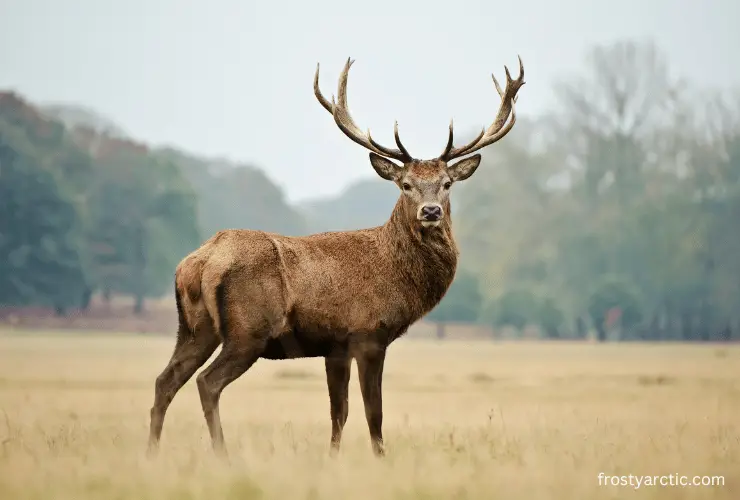
The term “deer” generally refers to any member of the family Cervidae. This family includes 43 different species other than reindeer, such as the
- White-tailed deer (Odocoileus virginianus),
- Red deer (Cervus elaphus)
- European fallow deer (Dama dama)
- Roe deer (Capreolus capreolus)
- Elk (Cervus canadensis)
- Sambar deer (Rusa unicolor)
- Moose (Alces alces)
- And many others
| Classification Level | Reindeer | Deer |
| Kingdom | Animalia | Animalia |
| Phylum | Chordata | Chordata |
| Class | Mammalia | Mammalia |
| Order | Artiodactyla | Artiodactyla |
| Family | Cervidae | Cervidae |
| Genus | Rangifer | Multiple (e.g., Odocoileus, Cervus) |
| Species | tarandus | Multiple (e.g., virginianus, elaphus) |
Habitat and Distribution
Reindeer are specifically adapted to cold regions; deer, in general, can be found in a variety of climates and habitats around the world.
Reindeer
Reindeer are located in the north-most parts of the world. They inhabit the Arctic and Subarctic regions, tundra, boreal, and mountainous regions of North America, Europe, and Asia.
Their habitats can be broadly divided into two based on the seasons, as detailed by the World Wildlife Fund.
- In summer, they prefer areas of tundra
- In winter, they move to boreal forests, also known as taigas.
Reindeer have a circumpolar distribution and are native to areas including
- Scandinavia
- Siberia
- Greenland
- Alaska
- Canada,
- Parts of the northern United States.
Certain populations, especially those in North America (where they’re known as Caribou), undertake long migrations between summer and winter habitats.
Deer
Deer species are widely distributed across the globe. Their habitats include
- the dry lands of the Middle East,
- the deciduous forests of North America,
- the dense rainforests of South America and Southeast Asia.
For example, the red deer is native to Europe, Asia Minor, parts of western Asia, and central Asia. It also has populations introduced to other parts of the world, including New Zealand and Argentina. ~ Source
| Attribute | Reindeer | Deer |
| Habitat | Arctic and Subarctic regions, tundra in summer, boreal forests in winter | Broad variety, from arid lands to forests and rainforests |
| Distribution | Native to Scandinavia, Siberia, Greenland, Alaska, Canada, parts of the northern U.S. | Globally distributed, excluding Antarctica and Australia |
Physical Appearance
Reindeer and other deer species possess distinct physical traits that set them apart.
Reindeer

- Antlers: Reindeer are known for their impressive antlers, which both males (bulls) and females (cows) develop – though bulls typically have bigger ones.
- Coat: Their fur, or pelage, is double-layered and is denser than other deer species, which helps them survive harsh Arctic winters. The underlayer is woolly, and the top layer consists of hollow, tubular hairs that trap air, providing insulation and buoyancy in water. Their fur color varies from white to dark brown, depending on the season and individual.
- Hooves: Reindeer have large, concave hooves that are adapted for a variety of tasks. They serve as paddles when swimming, scoops for digging in the snow for food, and provide solid footing on ice and rocky terrain.
- Legs: Reindeer have relatively short, muscular legs compared to other deer species. Their legs are well adapted for endurance walking and running, which comes in handy during their long seasonal migrations.
- Nose: They have a specialized nose that warms incoming cold air before it reaches the lungs and a unique circulatory system adapted to handle low temperatures and high altitudes.
- Size and weight: An adult reindeer can weigh between 150 and 550 pounds 5.5-6.5 feet long and typically stand about 2.5 to 5 feet tall at the shoulder.
Deer
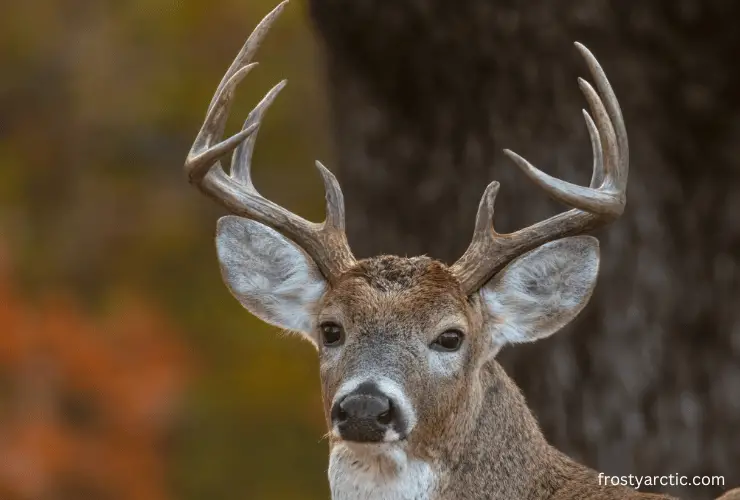
- Antlers: In most deer species, only the male deer grow antlers.
- Coat: Other deer species also have a double-layered coat, but these coats are not as dense or as insulating as the reindeer. They generally have reddish, brown, or gray coat, often with white underparts.
- Hooves: Most deer species have slender, split hooves well-suited for running and agile movement in their respective habitats.
- Legs: Most other deer species have longer, slender legs built more for speed and agility.
- Size: The size of deer can greatly vary depending on the species. For instance, the Southern Pudu, the world’s smallest deer, stands just 13-14 inches at the shoulder, while the Moose, the world’s largest deer, can stand over 6.5 feet.
| Attribute | Reindeer | Deer |
| Antlers | Both males and females grow antlers. | Mostly only males grow antlers |
| Coat | Dense, double-layered coat, varying from white to dark brown | Less dense; Generally reddish, brown, or gray with white underparts |
| Legs/Hooves | Short, muscular legs with large, concave hooves | Longer, slender legs with split hooves |
| Size | 5.5-6.5 ft long; 2.5-5 ft tall | from 13 in. to 6.5 ft tall |
Diet and Feeding Habits
Both reindeer and deer are herbivorous ruminants. Their specific diets and feeding habits differ based on their species and the habitats they occupy.
Reindeer
Reindeer eat a variety of vegetation. Their diet changes significantly with the seasons.
- In the summer, when food is more abundant, they eat various plants, including grasses, sedges, leaves, and herbs.
- During the harsh winter months, they feed mainly on the shoots of woody plants, lichens, especially reindeer moss – a type of lichen that survives under the snow.
Reindeer also eat lemmings, fish, and bird eggs, but plant material makes up most of their diet.
They use their large, concave hooves and strong legs to dig through the snow and reach their food.
Deer
Deer diets vary based on the species and their habitat. Most deer eat a mix of grasses, leaves, shoots, berries, and, in the case of woodland and forest deer, a lot of tree bark and twigs.
The white-tailed deer, for example, feeds on a wide variety of plant foods, including
- Leaves
- Twigs
- Fruits
- Nuts
- Corn
- Alfalfa
- Lichens.
Red deer mainly graze on grasses, sedges, heather, and tree shoots.
| Attribute | Reindeer | Deer |
| Diet | Grasses, sedges, leaves, herbs, and lichens; occasional lemmings, fish, and bird eggs | Grasses, leaves, shoots, berries, tree bark, and twigs; specific diet depends on the species |
| Feeding habits | Seasonal change in diet; uses hooves to dig for food in winter | Generally forages for a mix of available plant foods; specific feeding habits depend on the species |
Social Behavior
Both reindeer and deer display social behaviors and form groups. But the size and composition of these groups can vary greatly depending on the species and time of year.
Reindeer
Reindeer are herd animals and show gregarious behavior. Herd size varies greatly depending on the season, availability of food, and presence of predators, among other factors.
During migration, reindeer form large herds consisting of thousands of individuals. These herds can contain individuals of all sexes and ages in winter.
In contrast, during the summer months, reindeer tend to segregate by sex and age, forming smaller, separate groups of cows with calves and groups of bulls.
Deer
Deer are generally social animals, but the size and composition of their groups can greatly vary depending on the species and season.
For example, white-tailed deer tend to form matriarchal societies, as documented in the Journal of Mammology. Adult females will form family groups consisting of the adult female and her offspring from the current and previous years.
Male deer, or bucks, tend to be more solitary or form small bachelor groups, particularly outside of the rutting season.
| Species | Social Structure |
| Reindeer | Form large, mixed-sex herds in winter, segregated by sex and age in summer |
| Deer | Varies by species; many form matriarchal family groups |
Reproduction and Lifecycle
The reproduction and lifecycle of reindeer and Deer are quite similar, with some differences.
Reindeer
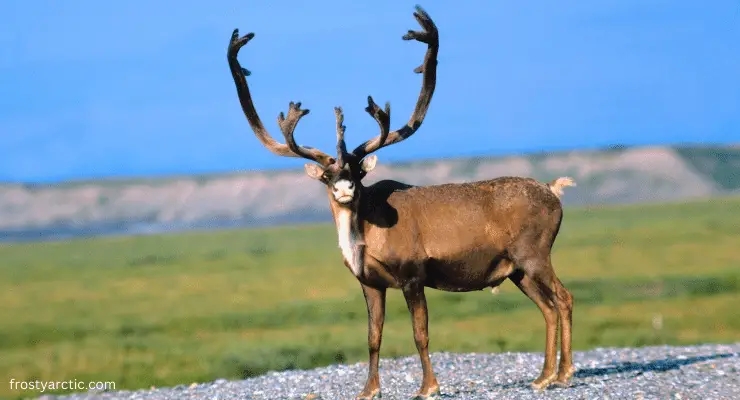
Reindeer have a reproductive cycle that is closely tied to the changing seasons.
Males, called bulls, compete for access to females, or cows, in the autumn, typically in late September or early October. This is when the bulls’ antlers are fully grown and in peak physical condition. They use their antlers in battles for dominance and access to females, as detailed in Animal Reproduction Science.
Once a bull has secured a group of females, he will mate with several. The gestation period for reindeer is about 7.5 months, meaning that most calves are born in the late spring, typically in May or June.
A calf weighs about 13 pounds at birth and can stand and nurse within an hour. Calves are usually weaned at about six months old.
Reindeer have a lifespan of around 15 years in the wild, though some have been known to live longer.
Deer
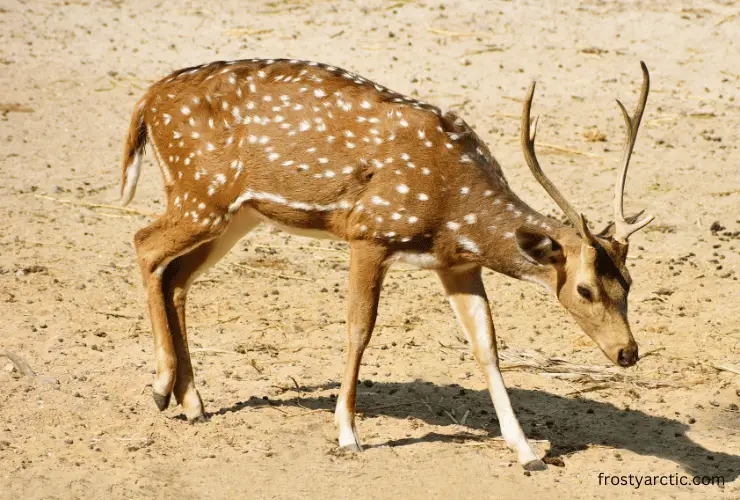
Reproduction in deer is generally quite similar to that of reindeer. Males, or bucks, also compete for access to females, or does, during a period known as the rut, which typically occurs between September and February. Bucks use their antlers to fight other males.
After mating, the gestation period in deer varies by species, but it’s typically around 6.5 to 7.5 months.
Most deer give birth to one or two offspring, or fawns, in the spring or early summer. Like reindeer calves, fawns can stand and nurse shortly after birth and are typically weaned at around six months.
The lifespan of deer varies widely depending on the species, whether they live in the wild or captivity. It’s generally around 3 to 10 years.
| Attribute | Reindeer | Deer |
| Mating Season | late September or early October | September to February |
| Gestation Period | About 7.5 months | Typically 6.5 to 7.5 months |
| Offspring | Usually one calf born in late spring | Usually 1-2 fawns born in spring or early summer |
| Lifespan | Around 15 years in the wild | Generally around 3-10 years |
Natural Predators
Reindeers and Deer rank among the region’s most formidable creatures. But they are not completely free from threats.
Reindeer
Reindeer being large herd animals, have few natural predators. However, large predators occasionally prey upon them in their Arctic habitats.
The primary predators of reindeer include
- Gray wolves,
- Mountain lions,
- Arctic foxes,
- Brown bears,
- Coyotes.
Additionally, golden eagles have been known to prey on reindeer calves.
Deer
The specific predators of deer vary depending on the species and their geographic location. In North America, common predators of white-tailed deer, for example, include wolves, cougars, bobcats, and coyotes.
In Europe, red deer are commonly preyed upon by wolves and lynx. Smaller deer species, such as roe deer, can also fall prey to foxes and large birds of prey.
| Species | Natural Predators |
| Reindeer | Wolves, brown bears, Arctic foxes, mountain lions, coyotes, golden eagles |
| Deer | Wolves, cougars, bobcats, coyotes, lynx, foxes, large birds of prey |
Defense Mechanism
Both reindeer and deer have developed impressive defense mechanisms to protect themselves against threats.
Reindeer
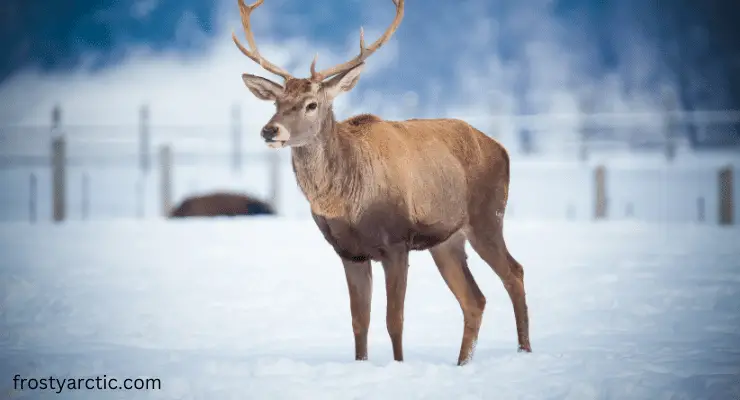
Reindeer rely on several strategies to protect themselves from predators.
- Herd behavior: One of the primary defense mechanisms of reindeer is herd behavior. A large group of animals can be intimidating to a predator, and individuals in the middle of the herd are less likely to be targeted.
- Speed and Endurance: Reindeer are notable for their impressive speed and endurance. They can run up to 80 km/h and swim at 6.5 km/h. This speed allows them to escape from predators in many situations.
- Sense of smell and hearing: Their strong sense of smell and hearing also alert them to the presence of predators, giving them time to flee.
- Antlers: Moreover, male reindeer use their large, sharp antlers to defend themselves during the mating season.
Deer
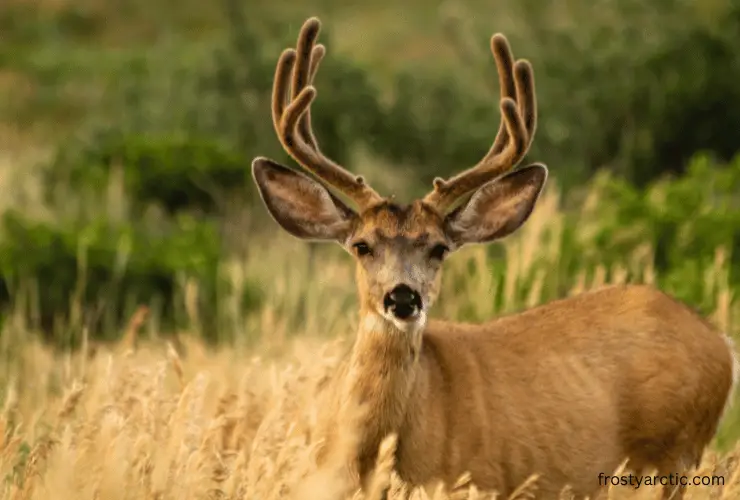
The defense mechanisms of deer are quite similar to those of reindeer.
- Speed and agility: Deers rely heavily on their speed and agility to evade predators. They are known for their bounding leaps and high-speed sprints, which can help them quickly escape danger. ~ Source
- Sense of smell and hearing: Deer have excellent hearing and a keen sense of smell, which can alert them to the presence of predators. When a deer senses danger, it will often “flag,” or raise its tail, alerting other deer to the potential threat. ~ Source
- Antlers: Male deer, or bucks, have antlers that they can use to defend themselves against predators, particularly during the rutting season.
| Attribute | Reindeer | Deer |
| Herd Behavior | Yes, can deter predators | Varies by species; some deer species form groups |
| Speed and Agility | Can run up to 80 km/h and swim at 6.5 km/h | Known for their agility and high-speed sprints |
| Senses | Strong sense of smell and hearing. | Excellent hearing. Keen sense of smell |
| Antlers or Horns | Males use antlers for defense | Males use antlers for defense |
Interaction With Humans
Reindeer and deer interact with humans differently.
Reindeer
Reindeer have had a long-standing relationship with humans, especially with indigenous peoples of the Arctic. The Sami people of Scandinavia and the Nenets people of Russia have relied on reindeer for thousands of years for transportation, food, clothing, and other materials, as documented in the journal Arctic.
Reindeer are semi-domesticated and herded, which differs significantly from other deer species. They are also often used for pulling sledges in areas where they are traditionally kept.
Deer
Interactions between deer and humans are quite different. While deer are often hunted for meat and sport, they are generally wild and not domesticated. In some regions, however, deer are raised on farms for venison, hides, and antler velvet. ~ Source
In suburban and urban areas, deer can become a nuisance as they are known to eat garden plants and may cause traffic accidents. They can also harbour ticks that transmit Lyme disease.
On the other hand, deer are appreciated for their grace and beauty, and watching them has become a popular pastime. Some species, such as the Japanese sika deer in Nara Park, have become tourist attractions.
| Attribute | Reindeer | Deer |
| Domestication | Semi-domesticated, herded by humans for various uses | Generally not domesticated |
| Hunting | Hunted traditionally by indigenous peoples; also farmed | Hunted for meat and sport; can be farmed |
| Nuisance | Not typically a problem unless overgrazing affects vegetation. | Can be a nuisance in urban areas due to eating plants and causing traffic accidents |
| Cultural Significance | Known worldwide due to Christmas legend | Appreciated for their grace and beauty; some species are tourist attractions |
Threats and Conservation Status
Reindeers and Deer face several threats that impact their conservation status.
Reindeer
Reindeer face several threats due to human activities, including
- Climate change
- Habitat loss due to human activities such as mining, logging, and the creation of roads and other infrastructure.
Despite these threats, according to the IUCN, the reindeer is currently listed as ‘Vulnerable’.
Deer
The specific threats and conservation status of deer depend greatly on the species in question. Some species of deer are doing well and have populations that are considered stable.
For example, the white-tailed deer, common in North America, is listed as ‘Least Concern’ by the IUCN.
However, other species are threatened due to poaching and habitat loss. For instance, the Bawean deer, found only on the Indonesian island of Bawean, is listed as ‘Critically Endangered’ by the IUCN.
| Attribute | Reindeer | Deer |
| Major Threats | Climate change, habitat fragmentation, and loss due to human activities | Varies by species; can include habitat loss, poaching, and road accidents |
| Conservation Status (IUCN) | Vulnerable | Varies by species; can range from Least Concern to Endangered |
Wrapping Up
So, are reindeer and deer the same? No, a reindeer is one of the many species of deer. Both reindeer and deer share the Cervidae family lineage, but they are distinctly different species. Each has adapted beautifully to their unique environments, and their diets, behaviors, and human interactions are shaped accordingly.
From the Arctic landscapes where reindeer roam to the diverse habitats that various deer species inhabit, their differences highlight the wonderful diversity of life.
We hope this blog has helped you differentiate between deer and reindeer. Don’t hesitate to dive back for more informative comparisons!

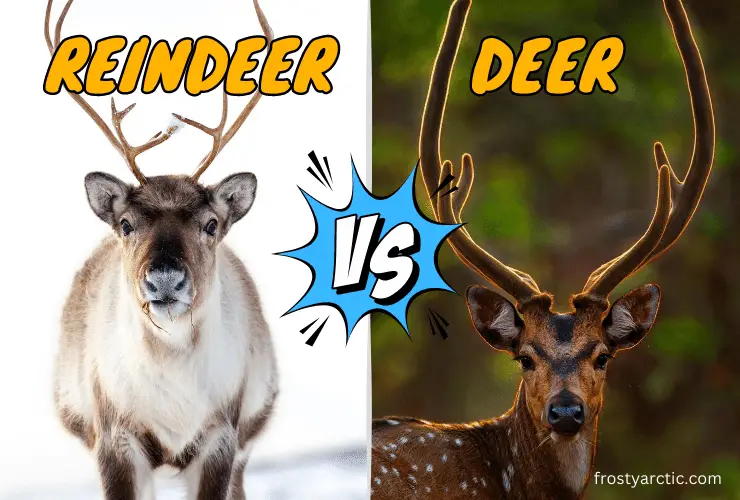

1 thought on “Reindeer Vs Deer: Key Differences Explained”